A $1 trillion infrastructure proposal is officially on the way later this year. Should we income investors buy any stocks now?
The answer’s yes – provided we avoid the popular names. After all, would you want to place your retirement hopes on the next spin of this roulette wheel?
Spin the Wheel on Retirement?
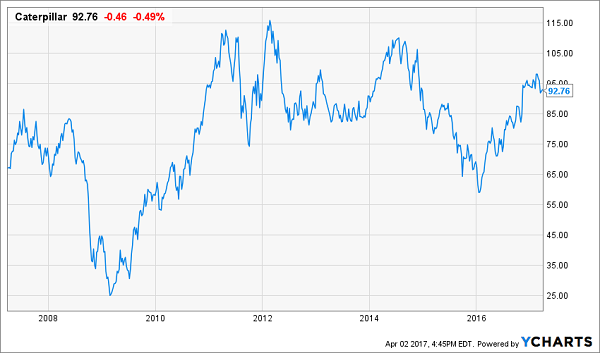
Caterpillar (CAT) is an industrial name you’ll hear mentioned often by stock pundits in the coming months. It’s a “cyclical” company that may indeed benefit from Trump’s trillion. But CAT buyers are taking on a lot of price heartburn for a modest 3.3% dividend.
And some popular picks pay even less. Jacobs Engineering Group (JEC), for example, just declared a dividend for the first time in its 45-year history as a public company. Its new yield? 1.1%.
If you like income and infrastructure, here’s a better plan:
- Demand 6% yields, and
- Get some price heartburn relief.
Too much to ask? It’s a short list of stocks and funds – but it exists. The select names on it have some sort of special structure, which allows them – or better yet, requires them – to pay big dividends.
Six Firms Built for 6% to 7.5% Infrastructure Payouts
Here are six stocks and funds that are “built to pay”:
BlackRock Utility and Infrastructure Trust (BUI) owns renewable power–focused utilities like NextEra Energy (NEE), master limited partnerships (MLPs) like Dominion Midstream Partners (DM) and water companies like American Water (AWK).
BUI pays a generous 7.3%, which is greater than the sum of its yields, thanks to its closed-end fund (CEF) structure. Its portfolio managers can leverage gains by borrowing cheap money at Libor (around 1.2%) – a benefit unique to CEFs.
Tortoise Energy Infrastructure (TYG), paying 7.5% today, was the first CEF to focus on MLPs. It predated the eventual MLP top by a decade, and the fund makes life easy for investors by liberating them from “K-1 hell.” They issue one 1099, and you’re done.
TYG is a bit too cyclical to buy and hold, however. The fund’s returns are great when energy prices move higher, but investors also must endure big drawdowns when energy prices retreat:
An Energy-Driven Roller Coaster
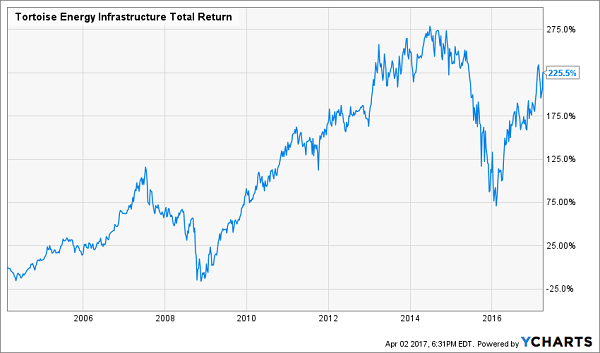
Plus the fund currently trades for a 12% premium to its net asset value (NAV) – which means you’re paying $1.12 for every $1 in MLP stocks the fund owns. That’s an expensive tax shortcut!’
Reaves Utility Income (UTG) is a more conservative play focused on traditional utilities and telecoms. Its holdings are cash cows that will keep dishing money to investors regardless of Washington politics. UTG pays 6% today, trades at a modest 3.7% discount to NAV and has an excellent 13-year track record:
A Relatively Drama-Free History

Macquarie Global Infrastructure Fund (MGU) is a unique high yielder – it pays a big dividend (6.5%) and boosts its payout. Investors have enjoyed three dividend increases over the past five years totaling 54%:
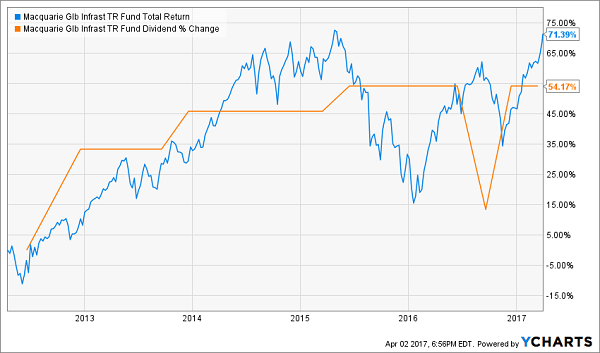
With 60% of its portfolio allocated outside the U.S., it’s the purest play on global infrastructure spending of the four we’ve discussed. Investors enjoy cheaper valuations abroad along with access to foreign infrastructure blue chips (such as the firm that manages – and collects tolls from – the Eurotunnel).
And My Two Favorites
The Cohen & Steers Infrastructure Fund (UTF) is a perennial favorite of mine. The fund owns a well-curated blend of infrastructure companies with a 55/45 blend of U.S. and overseas companies. The portfolio managers have always been skilled stock pickers, with UTF traditionally delivering high-single-digit returns.
My Contrarian Income Report subscribers done even better, thanks to the big 16% discount to NAV we took advantage of when we bought shares. Since we purchased UTF just fourteen months ago, we’ve enjoyed 32% total returns including dividends:
Our 32% Returns in 14 Months
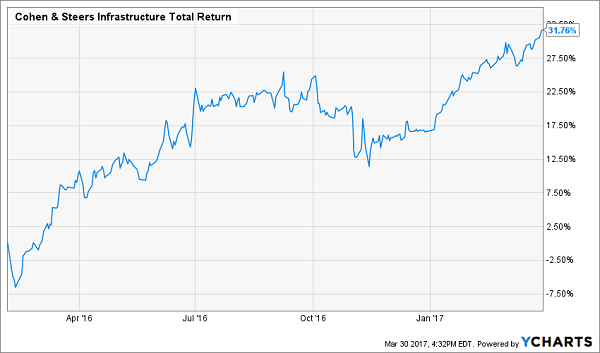
UTF has rallied above my recommended buy price. But if you’re looking for a place to put new money right now, I have another 6% payer with 30% to 40% price upside.
My favorite infrastructure stock was granted REIT (real estate investment trust) status four years ago thanks to its energy efficiency and renewable energy assets.
This is key because, as you probably know, REITs must pay out most of their income (90% or more) as dividends. In return, they are able to deduct these dividends, which means they generally pay little or no corporate taxes.
We income investors are the main beneficiaries, because we can enjoy a 6.6% current yield with plenty of future dividend upside thanks to profits that are growing by double-digits annually:
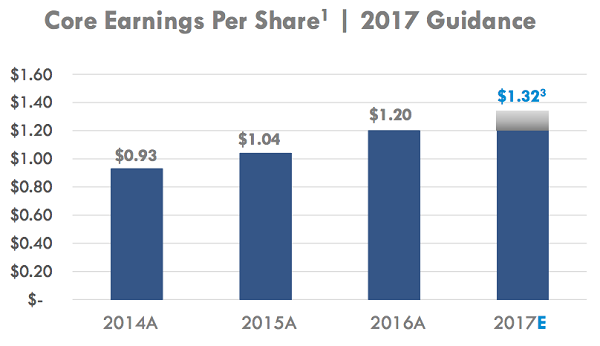
The only infrastructure REIT ever approved by the IRS is the latest addition to my 8% “No Withdrawal” Portfolio. Sick of “grinding out dividends” with 3% income pretenders? Trade them in for my 8% payers to almost-triple your dividends without sacrificing any upside either. Click here and I’ll share my eight favorite 8% ideas with you, including this REIT, along with names, tickers and buy prices.
